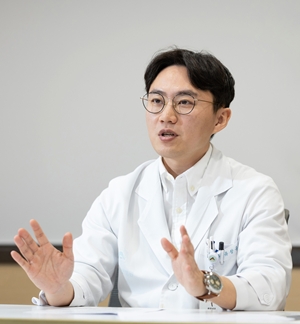- AZ 'Imfinzi' leads the paradigm shift in cholangiocarcinoma
- by Whang, byung-woo | translator Hong, Ji Yeon | May 16, 2025 06:18am
As new treatment options for cholangiocarcinoma are introduced, a paradigm shift is said to be brought to this area, which was previously neglected and poorly developed.
Although it is too early to be certain of long-term survival in South Korea, Dr. Yoo says that it could be a game-changer since new treatment options can benefit patient.

The prevalence of cholangiocarcinoma is known to be higher in Asia regions, including South Korea, China, and Taiwan, compared to Western countries. However, patients are often in advanced stages when diagnosed due to the challenging early diagnosis. It is one of the cancers that is difficult to reach a curative intent.
Dr. Yoo explained, "Cholangiocarcinoma has a low prevalence due to its high mortality, resulting in a low cumulative patient number relative to its incidence. Currently, only about 20–30% of cholangiocarcinoma patients are eligible for surgery, and the remaining approximately 70% must rely on drug treatments such as chemotherapy or immunotherapy."
While liver fluke infection was the leading cause of cholangiocarcinoma in the past, new factors such as fatty liver have emerged due to the westernization of dietary habits.
임핀지(더발루맙)After Imfinzi (durvalumab) received approval from the Ministry of Food and Drug Safety in November 2022, it is continuously expanding its influence.
Dr. Yoo said, "Although less than three years have passed since the indication approval and it is therefore difficult to confirm long-term survival rates, in clinical practice the proportion of patients showing improvement has increased compared with before," adding, "Considering that patients who received Imfinzi combination therapy early in the 2021 clinical study still have favorable outcomes, Imfinzi can be seen as providing benefits to patients."
In particular, Dr. Yoo focused on Imfinzi's side effects and safety.
Dr. Yoo explained, "Most side effects are caused by the cytotoxic chemotherapy agents used in combination, and there are almost no issues attributable to Imfinzi. It rarely causes patients to struggle or reduces clinical efficacy, making it a medication that is of considerable help not only to patients but also to healthcare providers."
"Korean subgroup analysis data on Imfinzi demonstrates long-term survival effects"
Another reason why Imfinzi combination therapy is gaining attention in cholangiocarcinoma is that overall survival (OS) was shown to be higher in Korean patients.
According to the study results, the two-year survival rate in the Korean patient group receiving the Imfinzi combination therapy was 38.5%, more than twice the 14.1% observed in the group that received chemotherapy.
Furthermore, the survival rate at 36 months was 21.0% in the Imfinzi combination group, more than double the 8.8% in the chemotherapy group.
Dr. Yoo analyzed, "In my opinion, I consider the Korean subgroup analysis data from the TOPAZ-1 study very encouraging. These results reflect the rapid accessibility and thorough patient management within the healthcare system."
In cholangiocarcinoma, where inflammation or adverse reactions often occur during anticancer treatment, leading to treatment interruptions and repeated hospital admissions and discharges, continuous cancer treatment itself is challenging.
According to Dr. Yoo, it is particularly common for treatment to be paused for a month or two due to inflammation, worsening the disease, and cholangitis can occur even when the cancer itself is not progressing. Therefore, high accessibility to treatment is critical in cholangiocarcinoma.
Dr. Yoo said, "In Korea, if inflammation or jaundice occurs, patients can quickly visit a hospital, receive a procedure, and recover, thereby immune checkpoint inhibitors can be administered continuously," and added, "Compared to countries with less-established healthcare systems, our accessibility and level of care are higher, so I believe the effectiveness of immune checkpoint inhibitors can be more pronounced."
Dr. Yoo also said, "Cholangiocarcinoma is indeed a challenging disease, but prognosis has improved recently and long-term survival cases are increasingly common," and added, "To secure approval or reimbursement for new drugs, one side's opinion is not enough. It is also necessary for patients and healthcare professionals to raise their voices together."
Reimbursement discussions remaining for Imfinzi combination Therapy… "The standard criteria application should be avoided"
However, the Imfinzi combination therapy is only reimbursed for the chemotherapy, and the cost barrier remains high.
Currently, Imfinzi's reimbursement criteria were established in November of last year. Following AstraZeneca Korea's application for the cost‐effectiveness track, the Health Insurance Review and Assessment Service (HIRA)'s Economic Evaluation Committee is expected to discuss Imfinzi's cost‐effectiveness this month.
According to industry sources, this month's Economic Evaluation Committee will review the cost‐effectiveness of Imfinzi+gem-cis combination therapy as a first‐line treatment for locally advanced or metastatic cholangiocarcinoma. It will be forwarded to the Drug Reimbursement Evaluation Committee if it passes the Economic Evaluation Committee.
In this regard, Dr. Yoo noted that, for the sake of patient access, the standard criteria should be avoided.
For example, in hepatocellular carcinoma, the standard treatment, sorafenib, is not particularly low‐cost, so its price could not be matched when a new drug emerged. Still, it is disadvantageous for a new drug to meet such price benchmarks for rare diseases or those where drug development has lagged.
Dr. Yoo said, "When nanoliposomal irinotecan was introduced as a second‐line treatment for pancreatic cancer, it also faced challenges in economic evaluation when compared with 5‐FU." And added, "Likewise, I do not think conducting a straightforward economic comparison between existing cholangiocarcinoma drugs, whose patents have expired and thus are inexpensive, and an innovative new drug developed after a decade is appropriate."
Dr. Yoo also described cholangiocarcinoma as 'the lung cancer of the gastrointestinal cancer family,' emphasizing the importance of precision medicine in new drug development.
"Although cholangiocarcinoma has one of the poorest prognoses among gastrointestinal cancers, I am interested in the possibility of developing targeted therapies based on genetic analysis of specific biomarkers," Dr. Yoo added, "Approximately 4–5% of cholangiocarcinoma patients carry specific gene mutations, making this a cancer type with high potential for precision‐medicine application, and research is underway."
Finally, Dr. Yoo urged, "Support for precision medicine and targeted‐therapy development is urgently needed to broaden patient treatment opportunities." And, "I hope that cholangiocarcinoma patients will not lose hope and will actively pursue their treatments."
-

- 0
댓글 운영방식은
댓글은 실명게재와 익명게재 방식이 있으며, 실명은 이름과 아이디가 노출됩니다. 익명은 필명으로 등록 가능하며, 대댓글은 익명으로 등록 가능합니다.
댓글 노출방식은
댓글 명예자문위원(팜-코니언-필기모양 아이콘)으로 위촉된 데일리팜 회원의 댓글은 ‘게시판형 보기’와 ’펼쳐보기형’ 리스트에서 항상 최상단에 노출됩니다. 새로운 댓글을 올리는 일반회원은 ‘게시판형’과 ‘펼쳐보기형’ 모두 팜코니언 회원이 쓴 댓글의 하단에 실시간 노출됩니다.
댓글의 삭제 기준은
다음의 경우 사전 통보없이 삭제하고 아이디 이용정지 또는 영구 가입제한이 될 수도 있습니다.
-
저작권·인격권 등 타인의 권리를 침해하는 경우
상용 프로그램의 등록과 게재, 배포를 안내하는 게시물
타인 또는 제3자의 저작권 및 기타 권리를 침해한 내용을 담은 게시물
-
근거 없는 비방·명예를 훼손하는 게시물
특정 이용자 및 개인에 대한 인신 공격적인 내용의 글 및 직접적인 욕설이 사용된 경우
특정 지역 및 종교간의 감정대립을 조장하는 내용
사실 확인이 안된 소문을 유포 시키는 경우
욕설과 비어, 속어를 담은 내용
정당법 및 공직선거법, 관계 법령에 저촉되는 경우(선관위 요청 시 즉시 삭제)
특정 지역이나 단체를 비하하는 경우
특정인의 명예를 훼손하여 해당인이 삭제를 요청하는 경우
특정인의 개인정보(주민등록번호, 전화, 상세주소 등)를 무단으로 게시하는 경우
타인의 ID 혹은 닉네임을 도용하는 경우
-
게시판 특성상 제한되는 내용
서비스 주제와 맞지 않는 내용의 글을 게재한 경우
동일 내용의 연속 게재 및 여러 기사에 중복 게재한 경우
부분적으로 변경하여 반복 게재하는 경우도 포함
제목과 관련 없는 내용의 게시물, 제목과 본문이 무관한 경우
돈벌기 및 직·간접 상업적 목적의 내용이 포함된 게시물
게시물 읽기 유도 등을 위해 내용과 무관한 제목을 사용한 경우
-
수사기관 등의 공식적인 요청이 있는 경우
-
기타사항
각 서비스의 필요성에 따라 미리 공지한 경우
기타 법률에 저촉되는 정보 게재를 목적으로 할 경우
기타 원만한 운영을 위해 운영자가 필요하다고 판단되는 내용
-
사실 관계 확인 후 삭제
저작권자로부터 허락받지 않은 내용을 무단 게재, 복제, 배포하는 경우
타인의 초상권을 침해하거나 개인정보를 유출하는 경우
당사에 제공한 이용자의 정보가 허위인 경우 (타인의 ID, 비밀번호 도용 등)
※이상의 내용중 일부 사항에 적용될 경우 이용약관 및 관련 법률에 의해 제재를 받으실 수도 있으며, 민·형사상 처벌을 받을 수도 있습니다.
※위에 명시되지 않은 내용이더라도 불법적인 내용으로 판단되거나 데일리팜 서비스에 바람직하지 않다고 판단되는 경우는 선 조치 이후 본 관리 기준을 수정 공시하겠습니다.
※기타 문의 사항은 데일리팜 운영자에게 연락주십시오. 메일 주소는 dailypharm@dailypharm.com입니다.









